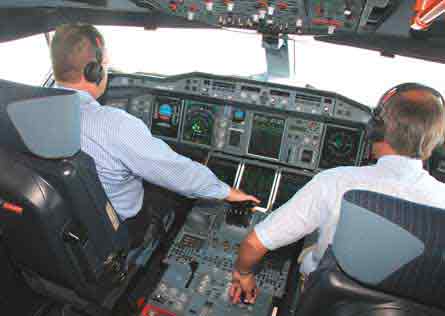UK study finds that risk of confusion during high crew workload could be cut by providing better visual feedback
Better visual feedback via an aircraft's primary flight display (PFD) of what the autopilot/flight management system (FMS) is doing reduces the likelihood of pilot mistakes when their workload is high, research has revealed. Autopilot mode confusion is just one of the risks that could be reduced by an improved autopilot information interface, say the researchers.
Sponsored by the UK Engineering and Physical Research Council (EPSRC), professor Peter Johnson and his colleague Rachid Hourizi at the University of Bath mocked up a "medium fidelity" flightdeck simulator, using personal computers, to see if they could improve pilot response to high workloads by providing more PFD feedback to the pilots, not only about manoeuvres being performed by the autopilot, but about their objectives. The team says it used an Airbus-type flightdeck layout and displays, but Hourizi says the study is applicable across all aircraft types.
|
|---|
Pilots perform better with visual feedback during autopilot manouevres |
All information programmed into the autopilot/FMS, and how the aircraft is responding at any given moment, is visible somewhere on the flightdeck, but is dispersed between the flight control unit, the PFD, the navigation display and the FMS multifunction control and display unit. Hourizi says it is not only the information dispersal that can be a problem, but what is presented or - more to the point - not presented on the PFD.
How a 'buddy' can help |
|---|
| The University of Bath's Rachid Hourizi gives examples of how the "buddy" autopilot interface improves the pilots' situational awareness: if the pilot sets a flight level change from FL100 to FL200 and actuates it, in the new prototype PFD a vector arrow would appear on the altimeter "tape" with 200 - the target flight level - above it. If the commanded manoeuvre were a heading change to starboard from 10° to 90°, a right vector arrow would appear above the compass arc with the target heading - 090 - next to it. As an attention-getter, the vector arrow would "twitch" momentarily in the opposite direction before displaying the direction and the objective - like cartoon characters who take a "wind-up" step back before whizzing off in the direction they want to go, says Hourizi. |
Johnson and Hourizi studied disciplined verbal communications used by military and firefighting units and found each effective message has three components: the present state, the action required, and the intended outcome or purpose. PFDs - the pilot's most immediate source of information - show the real-time aircraft performance resulting from the autopilot setting, but not the intended outcome of the manoeuvre, says the team. They have devised a system for providing, on the PFD, an intuitive display of the outcome of what the pilots have instructed the autopilot to do.
In trials of the prototype "buddy" autopilot interface, Johnson and Hourizi found that pilots performed better with the improved feedback, particularly when given sudden changes to carry out or malfunctions to deal with while performing autopilot-controlled manoeuvres.
The EPSRC says it has presented these findings to Airbus, BAE Systems and Qinetiq "and attracted a number of follow-on contracts".
Source: Flight International




















